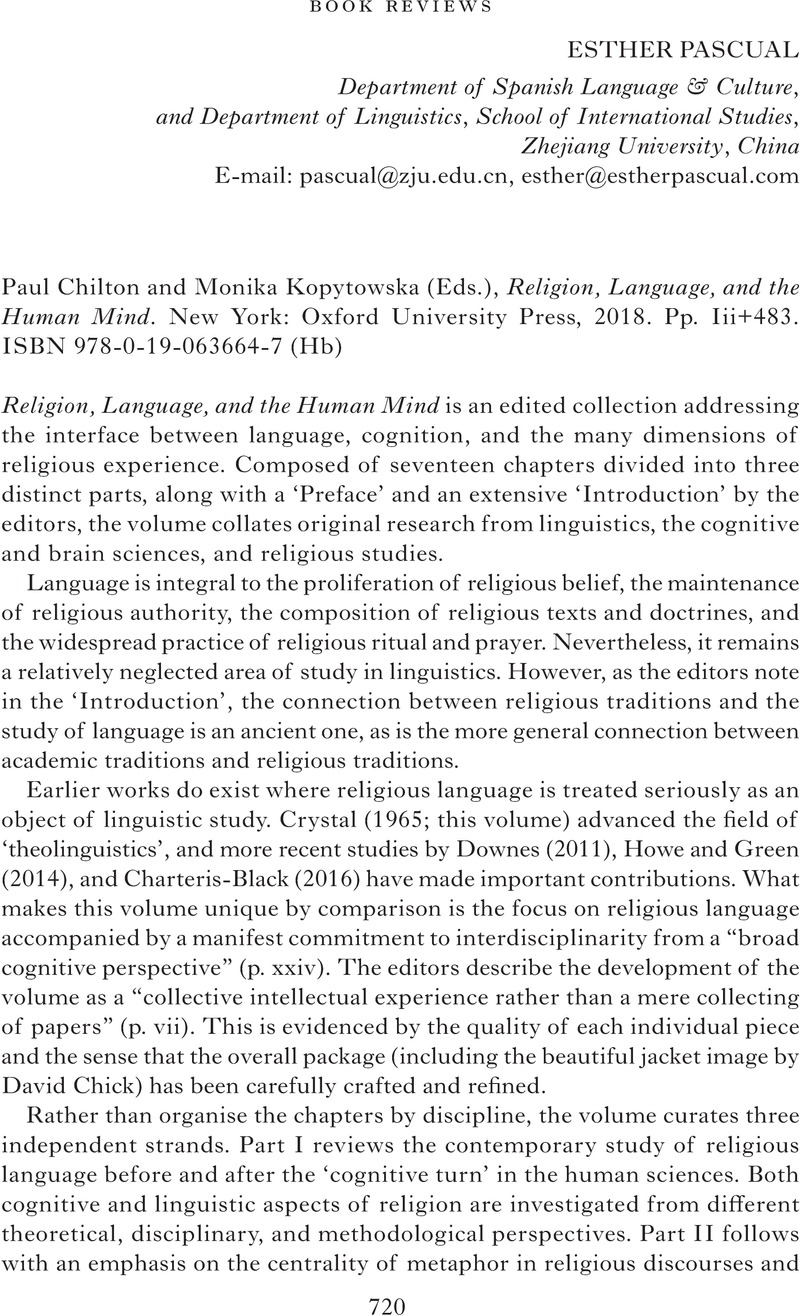No CrossRef data available.
Article contents
Paul Chilton and Monika Kopytowska (Eds.), Religion, Language, and the Human Mind. New York: Oxford University Press, 2018. Pp. Iii+483. ISBN 978-0-19-063664-7 (Hb)
Review products
Paul Chilton and Monika Kopytowska (Eds.), Religion, Language, and the Human Mind. New York: Oxford University Press, 2018. Pp. Iii+483. ISBN 978-0-19-063664-7 (Hb)
Published online by Cambridge University Press: 25 January 2019
Abstract
An abstract is not available for this content so a preview has been provided. Please use the Get access link above for information on how to access this content.

- Type
- Book Review
- Information
- Copyright
- Copyright © UK Cognitive Linguistics Association 2019
References
references
Boeve, L. & Feyaerts, K., (1999). Religious metaphors in a postmodern culture: transverse links between apophatical theology and cognitive semantics. In Bove, L. & Feyaerts, K. (eds.), Metaphor and God-talk (pp. 152–184). Bern: Lang.Google Scholar
Charteris-Black, J. (2004). Corpus approaches to critical metaphor analysis. London: Palgrave Macmillan.CrossRefGoogle Scholar
Charteris-Black, J. (2016). Fire metaphors discourses of awe and authority. London & New York: Bloomsbury Academic.Google Scholar
Chilton, P. (2014). Language, space and mind: the conceptual geometry of linguistic meaning. New York: Cambridge University Press.CrossRefGoogle Scholar
Downes, W. (2011). Language and religion: a journey into the human mind. Cambridge & New York: Cambridge University Press.Google Scholar
Howe, B. & Green, J. B. (eds.) (2014). Cognitive linguistic explorations in biblical studies. Berlin: De Gruyter.CrossRefGoogle Scholar
Kelemen, D. & Rosset, E. (2009). The human function compunction: teleological explanation in adults. Cognition, 111(1), 138–143.CrossRefGoogle ScholarPubMed
McGilchrist, I. (2009). The master and his emissary: the divided brain and the making of the western world. New Haven, CT: Yale University Press.Google Scholar
McNamara, P. (2009). The neuroscience of religious experience. Cambridge: Cambridge University Press.CrossRefGoogle Scholar
Pragglejazz Group (2007). MIP: a method for identifying metaphorically used words in discourse. Metaphor and Symbol , 22(1), 1–39.CrossRefGoogle Scholar
Sperber, D. & Wilson, D., (1995). Relevance: communication and cognition (2nd ed.). Oxford: Blackwell. (Original work published 1986.)Google Scholar
Tomasello, M. (2018). How children come to understand false beliefs: a shared intentionality account. Proceedings of the National Academy of Sciences of the United States of America, 115(34), 8491–8498.CrossRefGoogle ScholarPubMed
Van Noppen, J. P. (ed.) (1981). Theolinguistics. Brussels: Studiereeks Tijdschrift Vrije Universiteit Brussel.Google Scholar
Wierzbicka, A. (1996). Semantics: primes and universals. New York: Oxford University Press.Google Scholar



